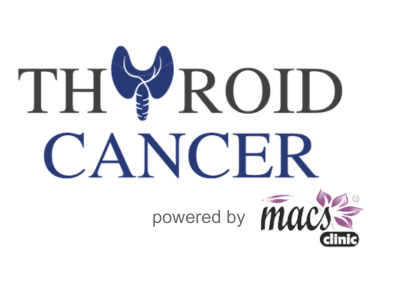Substernal or retrosternal Goiter
This page on retrosternal goitre contains the details about symptoms, diagnosis and management of the condition. Retrosternal or substernal goitres is a difficult condition to treat, especially when most of the gland is inside the chest. As a standard practice most centres offer open surgery with sternotomy. Opening chest with sternotomy wound is not needed in most of the situations as it is possible to perform robotic surgery especially in the hands of experts.
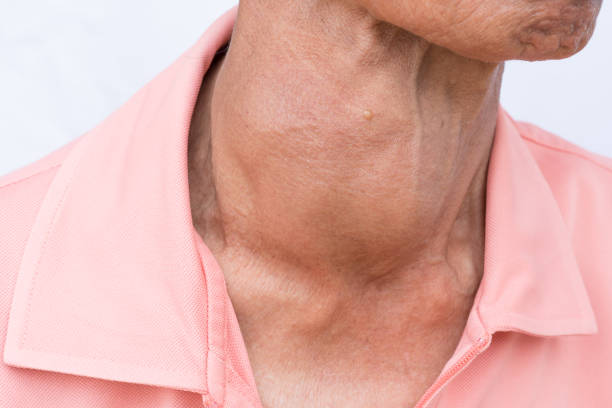
Substernal or retrosternal goiter is a condition where all or part of the thyroid gland extends into the chest, thereby causing pressure on nearby structures. This condition is challenging to manage and only a few centres around the world offer effective treatment. This page is developed by well-known thyroid surgeon, Dr Sandeep Nayak from MACS Clinic, Bangalore, India.
You can see this incredible story of a patient with retrosternal goiter from diagnosis to treatment using robotic surgery technique of robotic-assisted thoracoscopic surgery (RATS) and robotic-assisted breast-axillo insufflation thyroidectomy (RABIT) :
What is retrosternal thyroid goiter?
Retrosternal thyroid goiter refers to the big thyroid gland that grows so big that it exceeds the confines of the neck and penetrates the chest area, below the sternum. It is also known as retrosternal thyroid extension. Most of them consist of many nodules, and they may have a solid, cystic, or mixed appearance. A goiter is an abnormal enlargement of the thyroid gland, which often makes the neck look swollen. They are mostly painless and feel hard on touch.
Retrosternal goiter causes restrictive symptoms and may even hide thyroid cancer, which makes it challenging to treat. Moreover, they can displace vital structures, such as the food pipe, breathing tube, and main blood vessels.
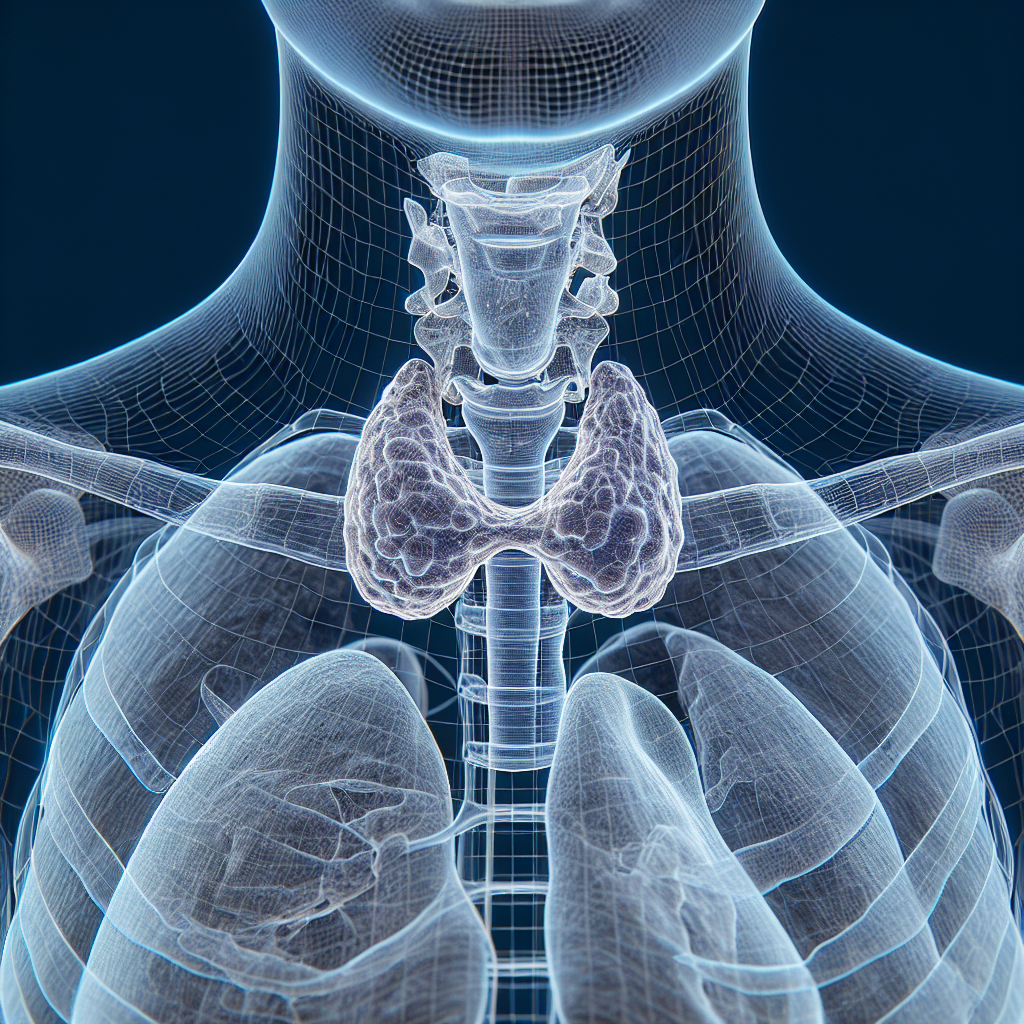
What is a substernal goiter?
An abnormal growth of the thyroid where around 50 percent of the gland extends into the chest is known as substernal thyroid gland.
However, like most goiters, it does not produce a large swelling in the neck because it grows inward toward the rear end of the neck and under the breast bone region into chest. This delays the onset of the symptoms until later when pressure builds up from restricted expansion against the sternum.
The leading cause of substernal thyroid gland is multinodular goiters that are present from a long time and have expanded into the chest cavity. About 5–15% of patients with thyroid goiters have substernal goiters.
What are substernal/retrosternal goiter symptoms?
As the thyroid is located above the windpipe and food pipe, the location and volume of the substernal goiter can cause restrictive symptoms.
However, around 15 to 50% of people will be asymptomatic. Retrosternal extension of thyroid symptoms is as follows:
Cough
Difficulty breathing
Wheezing
Hoarseness
Difficulty swallowing
Swelling of face
These symptoms are similar to those of people with goiters in the neck, but as the tumor is inside the chest cavity, it could be more serious.
How are substernal/retrosternal goiters evaluated?
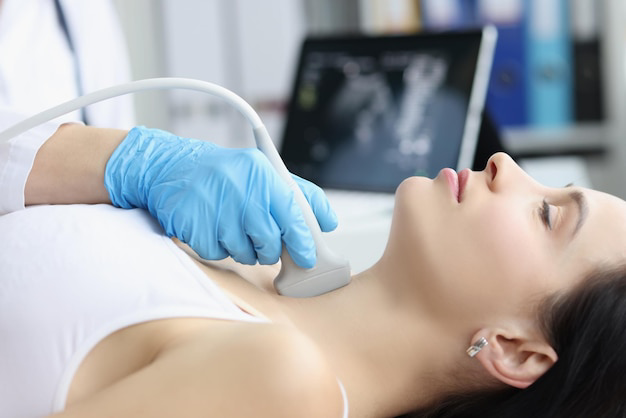
To evaluate a patient with a substernal/retrosternal goiter, the doctor will order several tests, such as:
Physical examination and medical history
Thyroid function test
CT scan with high resolution with contrast of chest and neck
Ultrasound of the neck
Fine needle aspiration cytology (FNAC)
Laryngoscopy to look at vocal cord
A biopsy is not always needed however, it may be essential when large goiters may be concealing thyroid cancers. A thorough assessment of lymph nodes is necessary for patients with retrosternal thyroid and if there is any concern of cancer, biopsy should be considered.
Is a CT scan necessary for diagnosing substernal/retrosternal goiter?
A physical examination and an ultrasound are not sufficient to fully determine the extent of a substernal or retrosternal goiter. Hence, a CT scan becomes essential for a comprehensive evaluation. Also, the CT scan shows the places where the thyroid goiter has reached, thus helping the thyroid surgeon develop a safe and efficient plan to remove the entire gland while protecting the surrounding structures. In certain rare cases, parts of the thyroid gland may have a dumbbell-shaped goiter or are separate from the primary goiter; therefore, a CT scan is necessary to detect any concealed masses behind the chest wall.
An incomplete operation is a possibility in the absence of this information. For this reason, a CT scan is necessary for imaging every instance of substernal/retrosternal goiter.
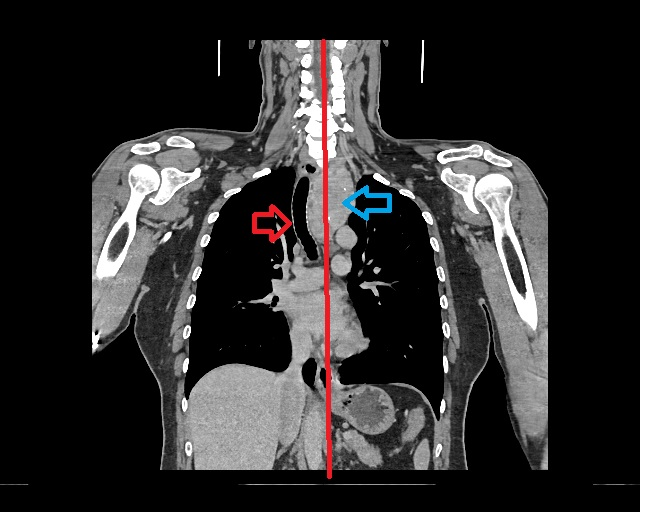
Figure 1 The image showing retrosternal thyroid (blue arrow) and pushing the windpipe (red arrow)
What are the surgical options for treating substernal/retrosternal goiter?
The best course of treatment for substernal/retrosternal thyroid goiters is surgery. The surgeon may recommend removal for several reasons, such as:
-
- All retrosternal thyroids need surgery as they can potentially cause problem.
- The goiter is causing difficulty in swallowing and breathing
- Multinodular goiters are causing severe symptoms
- Suspicious FNAC results indicating retrosternal/substernal goiter with cancer
Even though the substernal goiter extends into the chest, way below the breast bone, it can be removed quite successfully using sophisticated robotic surgery techniques like robotic-assisted thoracoscopic surgery (RATS) and robotic-assisted breast-axillo insufflation thyroidectomy (RABIT).
These surgical methods require no chest opening (sternotomy) and leave behind minimum scars. Dr. Sandeep Nayak and his team are experts in robotic surgeries and use the combination of RATS and RABIT techniques to successfully remove the retrosternal goiter. Robotic surgery avoids sternotomies, whereas conventional procedures require a lower neck incision along with sternotomy to remove the entire retrosternal gland. It is important to remember that only expert thyroid surgeons should perform these procedures, as inexperienced surgeons run the risk of performing an incomplete removal or of having problems preserving the vital tissues surrounding the thyroid gland.
Patients should seek an opinion from a highly experienced thyroid surgeon when advised about chest opening procedures because robotic surgery is often a practical and less invasive option. This aids in early recovery from treatment. Opening the chest is usually never essential in the surgical care of substernal/retrosternal goiters, and robotic surgery techniques such as RATS and RABIT can be used to efficiently treat most cases.
How to Reach Us!
Each year, our center welcomes many patients from all corners of the globe. With our extensive experience, we have streamlined the process to make it effortless for you to visit Bangalore for your evaluation, scans, biopsies, and surgery all in one trip. For your convenience, a significant portion of the follow-up can be conducted through online consultations. Additionally, we are committed to assisting you with postoperative treatment in your home country or city, eliminating the need for you to return to Bangalore, India.
Frequently Asked Questions
Where is the retrosternal goiter located?
A retrosternal goiter extends into the chest and is situated behind the breastbone. It is a form of enlarging thyroid gland that protrudes past the neck, compressing the chest cavity and possibly leading to difficulties.
Are substernal goiters malignant?
According to studies, there is a 9 to 13% risk for malignancy in substernal goiters. Getting biopsy from these extremely difficult
Do you require surgery for retrosternal goiters of all sizes?
Yes, retrosternal goiters compress adjacent structures and cause problem. They need to be removed irrespective of size.
